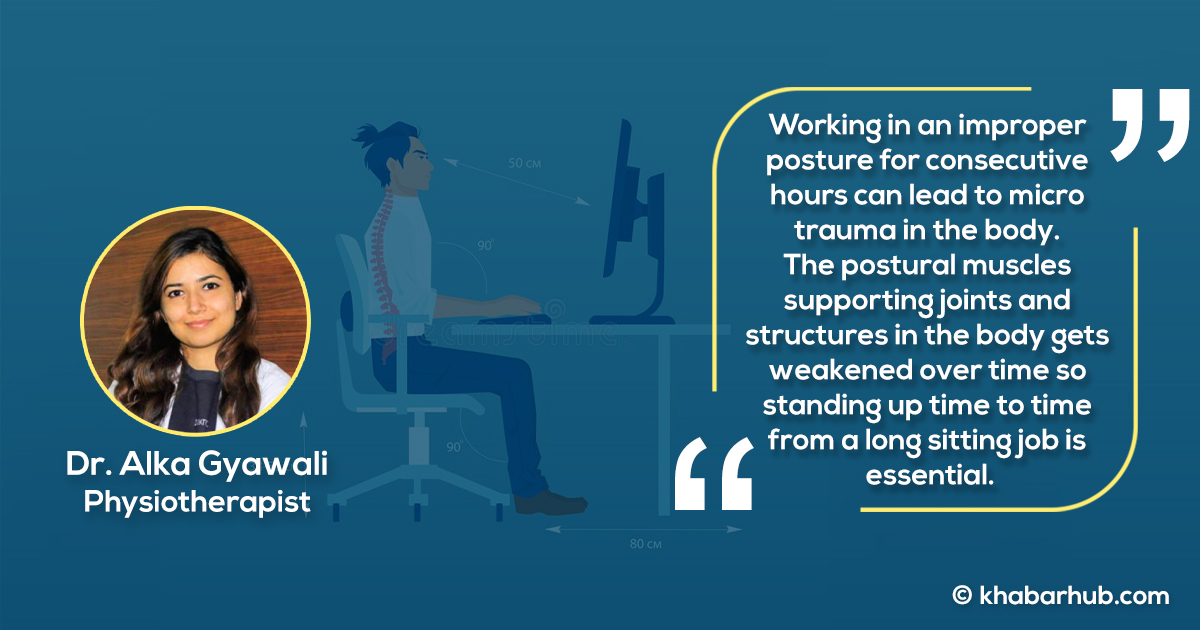0%

In this competitive time and situation, people remain busy with their works whether it is at the office, hospital, bank, or other places.
People seem to be least concerned about their health and health-related issues that could arise as a result of a poor working environment and handling habits.
We remain focused on the perfection of our performances in such a way that we tend to occupy ourselves for long 7-8 hours without a sound break in work and postures.
Yes! Working is essential to sustain our livelihood but working in poor posture and environment continuously can result in several musculoskeletal injuries.
There are two basic injuries, acute and chronic.
An acute injury is due to strong and short term heavy loads whereas chronic injury results from long term or permanent overload.
According to the cases I have received in my practice, most common work-related musculoskeletal injuries include Mechanical low back pain, Rhomboids and Trapezius strain, Cervical and Paravertebral muscle spasms, Trigger points, Carpel Tunnel Syndrome, Cervical and Lumbar spine degenerative conditions, Tennis Elbow, Tendinitis, Hip and knee injuries, etc.
Risks factors contributing to these injuries could be:
The exertion of high-intensity forces,
Handling loads for a long period of time,
Monotonous repetitive activities,
Working on unfavorable posture,
Long term muscular strain,
Poorly designed workstation,
Psychological factors like increased work stress etc.
How can we avoid these problems?
Ergonomic and workstation modification are the keys to get rid of all these work-related problems. Understanding ergonomics helps us to prevent pain or injury and create an appropriate balance between the requirements of the work and capacity of the working person.
Some of the important ergonomic advice:
Lift with both hands bringing load as close as possible to the body.
Lift heavy loads with an upright trunk by initially bending knees and avoiding manipulation of loads in unfavorable postures (e.g. lateral bending or twisting.)
Avoid pushing or pulling with only one hand.
Avoid pushing or pulling with strong lateral bending or twisted trunk.
If our work demands us to sit in front of a computer for a long 7-8 hours, then following are the tips for good posture and work station modification-
Sit on a high back chair to support our shoulder blades.
Adjust the chair height to get the thighs parallel to the floor and feet to rest flat on the floor.
Set the monitor or laptop screen at eye level. If the laptop or monitor screen is not at eye level, we can use a document holder or pile of books to adjust the height accordingly, this will save us from over bending and overstretching.
Rest the elbows on the armrest at a 90-degree angle.
Maintain wrist in a neutral position while using a mouse, keyboard, etc.
Keep everything that we need in official work close by or within easy reach because repeatedly reaching out for things while being seated at our workstation can strain our muscles.
Seat height should be adequately adjusted i.e. keeping our body at a 90-degree angle to our thighs to keep our spine aligned.
Change body posture frequently in order to reduce continuous static loading.
Take breaks or pauses for about 20-25 minutes between the works.
Did we know?
Working in an improper posture for consecutive hours can lead to microtrauma in the body.
The postural muscles supporting joints and structures in the body get weakened over time so standing up from time to time from a long sitting job is essential.
Keeping wallets in the back pocket disturbs our posture, puts pressure on our spine and causes it to be out of alignment.
It can also put pressure on Piriformis muscle which aggravates the sciatic nerve and can lead to sciatica.
Carrying handbags which include heavy contents like laptops, iPads, water bottles, etc on one shoulder leads to neck pain, shoulder pain as well as headaches.
Wearing high heels for a long time can create an unnatural posture through the spine which can lead to long term pain and dysfunction.
Sitting with our leg over our knee for long periods can cause our pelvis to rotate and tilt and ultimately lead to low back pain.
Talking on the phone for a long time with the gadget held between our ear and neck while we are working can cause neck muscles to become strained.
Sitting on a stool or chair that is too high causes our legs to hang which tilts our pelvis backward and disturbs muscular balance such that our core muscles have to compensate to a certain extent which can cause pain.
Continuously looking at mobile phones, iPads or laptops can lead to the development of slouch posture. That puts more pressure on discs and vertebrae of our back.
(Dr. Alka Gyawali is a Physiotherapist)